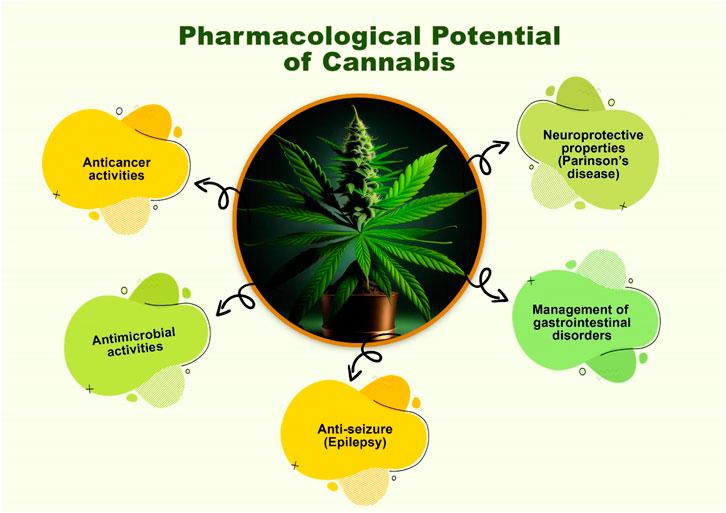Unraveling the Green Puzzle: The Many Components of Marijuana
Marijuana, often surrounded by a haze of social and legal debate, is much more than just a recreational herb. It is a complex plant rich in a variety of compounds that work together to create a spectrum of effects on the human body and mind. For those curious about the intricate makeup of this intriguing botanical, the question arises: just how many components are in marijuana? From the well-known cannabinoids like THC and CBD to a multitude of lesser-known terpenes and flavonoids, each element plays a crucial role in defining the plant’s diverse profiles and potential benefits. In this exploration, we aim to dissect these elements, shedding light on the fascinating chemistry of marijuana while demystifying what truly lies within this multifaceted plant. Join us as we delve into the science of cannabis and uncover the myriad components that make it a subject of both fascination and study.
Table of Contents
- Understanding the Complex Composition of Marijuana
- Exploring the Role of Cannabinoids in Cannabis Effects
- The Contribution of Terpenes to Aroma and Therapeutic Benefits
- Guidelines for Navigating Marijuana Products Based on Their Components
- Q&A
- Future Outlook
Understanding the Complex Composition of Marijuana
Marijuana is a complex plant made up of a multitude of chemical components that interact with each other to produce a variety of effects. At the core of its composition are cannabinoids, which are the primary active compounds responsible for most of the medicinal and psychoactive properties associated with cannabis. The most well-known cannabinoids include:
- THC (Tetrahydrocannabinol): The primary psychoactive compound.
- CBD (Cannabidiol): Non-psychoactive and praised for its therapeutic properties.
- CBG (Cannabigerol): Often referred to as the ‘mother’ cannabinoid due to its role in synthesizing other cannabinoids.
- CBN (Cannabinol): Known for its sedative effects.
In addition to cannabinoids, marijuana contains a variety of terpenes, which are aromatic compounds contributing to the unique scent and flavor of different strains. These terpenes also have potential therapeutic effects and can influence the overall experience of the user. Some common terpenes found in marijuana include:
- Myrcene: Known for its earthy aroma, it may promote relaxation.
- Limonene: Offers a citrus scent and is thought to elevate mood.
- Caryophyllene: Spicy in scent, it has potential anti-inflammatory properties.
- Linalool: A floral fragrance often associated with calming effects.
| Cannabinoid | Main Effects |
|---|---|
| THC | Psychoactive, euphoria, increased appetite |
| CBD | Non-psychoactive, anti-anxiety, anti-inflammatory |
| CBG | Potential neuroprotective, antibacterial |
| CBN | Sedative, may aid sleep |
Exploring the Role of Cannabinoids in Cannabis Effects
The intricate tapestry of cannabis effects can largely be attributed to the diverse range of cannabinoids present in the plant. Major cannabinoids like Tetrahydrocannabinol (THC) and Cannabidiol (CBD) are prominent players, each performing distinct roles in how users experience cannabis. THC is renowned for its psychoactive properties, inducing feelings of euphoria and altering perception, while CBD is celebrated for its therapeutic effects, such as anxiety relief and anti-inflammation, without the high associated with THC. This unique interaction defines the user’s overall experience and highlights the importance of balancing these cannabinoids for desired effects.
Beyond the well-known cannabinoids, cannabis contains over 100 additional compounds, less recognized yet equally significant. These include Cannabinol (CBN), Cannabichromene (CBC), and Cannabigerol (CBG), each contributing to a specific aspect of the plant’s effects and benefits. The entourage effect suggests that these cannabinoids work synergistically, amplifying or moderating each other’s effects. Understanding this symphony of components can empower users to tailor their cannabis experience according to their personal preferences and therapeutic needs. Below is a brief overview of some cannabinoids and their primary effects:
| Cannabinoid | Primary Effects |
|---|---|
| THC | Alters perception, induces euphoria |
| CBD | Anxiety relief, anti-inflammatory |
| CBN | Potential sedative effects |
| CBC | Pain relief, mood enhancement |
| CBG | Neuroprotective properties, antibacterial |
The Contribution of Terpenes to Aroma and Therapeutic Benefits
Terpenes play a significant role in the aromatic profile of marijuana, contributing not only to its distinct scent but also enhancing its therapeutic effects. These organic compounds are produced in various plants, including cannabis, and serve multiple purposes in nature, such as attracting pollinators or repelling pests. In marijuana, the rich tapestry of terpenes adds depth to the overall experience. Notable terpenes include:
- Myrcene – Known for its earthy and musky aroma, often linked to relaxing effects.
- Limonene – Offers a citrus scent while potentially uplifting mood and reducing stress.
- Caryophyllene – Features a spicy, peppery aroma and may have anti-inflammatory properties.
- Pinene – Reminiscent of pine forests, it may enhance alertness and memory retention.
Beyond aroma, terpenes also work synergistically with cannabinoids, creating an “entourage effect” that amplifies their overall medicinal properties. This intricate relationship underscores the importance of terpenes in medicinal marijuana, where different strains may offer unique therapeutic benefits targeted at specific conditions. A glance at the common therapeutic benefits linked with various terpenes reveals their potential:
| Terpene | Aroma | Therapeutic Benefit |
|---|---|---|
| Myrcene | Earthy, Musk | Anti-inflammatory, Sedative |
| Limonene | Citrus | Antidepressant, Stress Relief |
| Caryophyllene | Spicy, Peppery | Anti-inflammatory, Pain Relief |
| Pinene | Pine | Memory Enhancement, Alertness |
Guidelines for Navigating Marijuana Products Based on Their Components
When exploring marijuana products, understanding the various components is essential for making informed choices. The primary components of cannabis include cannabinoids, terpenes, and flavonoids, each contributing distinct effects and aromas. Cannabinoids, such as THC and CBD, directly interact with the body’s endocannabinoid system, producing therapeutic effects and psychoactive experiences. Terpenes, on the other hand, are aromatic compounds that contribute to the plant’s scent and flavor, and they may also enhance or modify the effects of cannabinoids. flavonoids serve as antioxidants and add unique colors to the buds, possibly influencing the overall experience through their properties. Familiarizing yourself with these main components can help you match products to specific needs and preferences.
To further aid in navigating marijuana products, consider the following points:
- Full-Spectrum vs. Isolate: Full-spectrum products contain all cannabinoids and terpenes, promoting an “entourage effect,” whereas isolates contain only one cannabinoid, like CBD.
- Indica vs. Sativa vs. Hybrid: Indicas are typically calming, sativas are energizing, and hybrids offer a blend of effects tailored to user needs.
- Lab Testing: Always check for lab-tested products to ensure potency and safety, revealing the concentrations of key components.
| Component | Role |
|---|---|
| Cannabinoids | Interact with receptors, providing therapeutic effects |
| Terpenes | Add flavor, aroma, and potential therapeutic benefits |
| Flavonoids | Antioxidants that enhance taste and color |
Q&A
Q: How many components are found in marijuana?
A: Marijuana, scientifically known as Cannabis sativa, is a complex plant that contains over 400 different chemical compounds. Among these, approximately 100 are classified as cannabinoids, the most prominent being tetrahydrocannabinol (THC) and cannabidiol (CBD).
Q: What are cannabinoids, and why are they significant?
A: Cannabinoids are chemical compounds that interact with the body’s endocannabinoid system. THC is famous for its psychoactive effects, giving users a ”high,” while CBD has gained popularity for its therapeutic potential without the intoxicating effects. Together, they illustrate the diverse effects marijuana can have, ranging from euphoria to pain relief.
Q: Are there other important components in marijuana besides cannabinoids?
A: Absolutely! In addition to cannabinoids, marijuana contains terpenes and flavonoids. Terpenes, responsible for the plant’s aroma and flavor, may also contribute to its effects. Flavonoids play a role in pigmentation and may offer additional medicinal benefits, further enriching the marijuana experience.
Q: Why is it important to know about these components?
A: Understanding the various components of marijuana helps consumers make informed choices about their usage. Different strains have unique combinations of cannabinoids and terpenes, leading to varied effects and therapeutic potentials, allowing individuals to select options tailored to their needs.
Q: Do all marijuana plants have the same composition?
A: No, the composition can vary significantly between different strains of marijuana due to genetics, growing conditions, and harvesting methods. Some strains may be high in THC, while others could be more balanced with CBD. This genetic diversity is part of why cannabis has found use in both recreational and medicinal contexts.
Q: How do additional compounds influence the effects of marijuana?
A: The entourage effect is a proposed theory suggesting that cannabinoids, terpenes, and other compounds work together synergistically. This means the combined effects of these components can enhance the therapeutic benefits and alter psychoactive experiences, making the profile of each strain uniquely effective.
Q: Is it possible to isolate these components?
A: Yes, scientists have successfully isolated cannabinoids like THC and CBD for use in various products, from oils to edibles. This allows for specific applications, such as targeting pain relief or anxiety reduction, but some argue that using the whole plant may provide a more balanced approach to treatment.
Q: What’s the takeaway regarding marijuana’s components?
A: With over 400 compounds in marijuana, each playing a unique role, understanding this complexity can be empowering. As research continues to unfold, the significance of these components will likely lead to more personalized and effective applications in both recreational and medical contexts.
Future Outlook
the world of marijuana is a complex tapestry woven from a multitude of components, each contributing to the plant’s unique profile and effects. With over 100 cannabinoids, a rich assortment of terpenes, and a variety of flavonoids, understanding these elements not only enhances our appreciation of marijuana but also informs responsible consumption and potential therapeutic applications. As research continues to unfold, we can anticipate deeper insights into how these components interact and their roles within the ever-evolving narrative of cannabis. Whether for medicinal purposes, recreational enjoyment, or simple curiosity, the intricate interplay of these constituents invites us to explore further, celebrating the diversity that lies within this remarkable plant.



